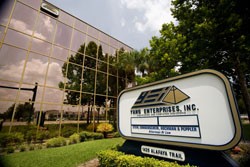To some, Clint Curtis is a hero.
;; He's the brave computer programmer who stood up to corruption in Tallahassee even though it cost him his job at the Florida Department of Transportation, and even though he believes exposing this very same corruption got a FDOT comrade killed.
;More importantly, he's walking, talking proof of a GOP conspiracy to rig the 2004 presidential election. For Democratic activists wondering how John Kerry lost to President George W. Bush when exit polls predicted otherwise, Curtis offers a satisfying explanation: Kerry didn't lose. Bush stole it again.
;Now, the hero is running for Congress, against the very man he says masterminded the vote-fixing scheme: Oviedo Republican Congressman Tom Feeney. But Feeney's diabolical deeds don't stop there, says Curtis. He also used his authority as then-Florida House Speaker to quash a state investigation into a company he represented as a lobbyist and lawyer, which Curtis believes was bilking the state and selling missile technology to China. Curtis also believes that FDOT investigator Raymond Lemme, who authorities say committed suicide in July 2003, was murdered because he was about to blow the lid on all this corruption.
;Not surprisingly, Feeney and his supporters tell a very different story. In their version, Curtis is a nut job, a charter member of the tinfoil-hat society; a man so entrenched in his own conspiracy theories that he spins wild, baseless accusations that aren't even plausible. As Feeney told the St. Petersburg Times in 2005, "All I can tell you is I didn't do any of the illegal things Curtis says I did, and I didn't lead the Martian invasion of Earth either."
;;"It is so outrageous," echoes Feeney spokeswoman Shannon Corrado. "The fact that people take this seriously … a lot of it turns my stomach."
;But some do, especially activists determined to prove that Republican chicanery — not Kerry's weak campaign — lost them the 2004 election. And they aren't making up their case from whole cloth. In December 2004, Curtis testified before a panel of House Democrats investigating charges of vote tampering in Ohio. And in 2005, he took — and passed — a polygraph test to bolster his claims.
;;So the question must be asked: Is Clint Curtis crazy, or did he stumble upon a massive GOP conspiracy that started in an Oviedo office and led to George Bush retaining the Oval Office four years longer than he should?
;;An unusual request
;Curtis' story — which first gained notoriety on www.bradblog.com and quickly went viral throughout the liberal blogosphere — begins in September or October of 2000, when he was employed as a computer programmer for Yang Enterprises Inc., an Oviedo company that works on contracts for NASA and FDOT. One day, Curtis says, Feeney came into YEI's office and asked a favor.
;;That Feeney, then a state House representative on track to become speaker, would stop by wouldn't have been unusual. Feeney's campaign office was, and is, located in the same building as YEI, at 1420 Alafaya Trail. The Yangs were — and still are — some of Feeney's biggest financial contributors, according to campaign disclosures; they've given $14,600 to his three congressional campaigns. Feeney was also the company's lobbyist to local governments, and he served as the company's lawyer. Two decades ago, he filed YEI's incorporation papers with the state.
;;On this visit, Curtis says Feeney wanted him to write a software program that could alter election results on electronic voting machines. Curtis, a lifelong Republican, assumed Feeney wanted to pre-emptively head off any Democratic attempts to steal elections. So he wrote the software.
;;The program installed hidden "buttons" on the screens of voting machines that would enable a user who knew they were there to recalibrate the tally, giving a preferred candidate 51 percent of the vote automatically, and splitting the remaining 49 percent of the vote among other candidates proportionately so that no one would be the wiser.
;;Curtis says he wrote the program in a day. In essence, it would allow anyone who knew the program to go to a precinct, pretend to vote and alter vote counts without anyone else, including supervisors of elections, knowing.
;;But when he turned in the program to Li-Woan Yang, YEI's co-owner, Curtis says he found out his assumptions about its intended use were wrong. He claims Yang told him he needed to "hide" the fraud in the source code, not to reveal it. The program was needed to "control the vote in South Florida," he says Yang told him.
;;"I thought she was nuts," he says. Even though Florida wasn't yet using touchscreen voting machines — the push for that would come after the botched November 2000 election — Curtis believes Feeney was planning ahead.
;;After developing the program, Curtis later stated in a 2004 affidavit, he sat in on a dozen meetings with Feeney and Yang in which Feeney discussed ways to skew elections. Feeney talked about suppressing the black vote via increased police patrols in black neighborhoods on Election Day, Curtis says. And he talked about using software, such as the prototype Curtis developed, to artificially reduce Democrats' margins of victories in their strongest precincts, thus altering vote totals inconspicuously.
;;Curtis says these meetings, along with other anomalies he noticed at YEI, prompted him to announce his resignation in January 2001. A few months later, he took a job at the FDOT's Office of Information Services in Tallahassee. But his dealings with YEI weren't over yet.
;;Although Curtis says he left YEI on good terms — he sent Orlando Weekly a copy of a card he says the company gave him when he left, which includes a handwritten note from Li-Woan Yang saying, "The door will be open for you when you need it" — it didn't take long before he butted heads with his former boss. He says after his departure, when the company found out he was working with FDOT and offered him "tons of money" to come back, he became suspicious of its motives. His FDOT supervisor, Mavis Georgalis, had her concerns as well.
;;Georgalis had been supervising YEI since 1999, when the company won an eight-year, $8 million state contract to overhaul FDOT's information database. At first, Georgalis says, YEI was a model contractor. Its invoices came in on time and accurate. But by the end of 1999, the contract's first year, the relationship soured. The company billed the state for more work hours than it should have, and turned in its invoices so late that she had little time to analyze them before paying the fees on time, as the contract required. By July 2000, things had gotten so bad that Georgalis required YEI to get pre-approval before it did any work.
;;"That's when all hell broke loose," she says. Georgalis says YEI made "very open threats" about FDOT's funding, because its lawyer was in line to be House Speaker and held huge sway over the budget. The company called the state comptroller to complain about not getting paid, and it hired a lobbyist tied to both Feeney and Gov. Jeb Bush to press its case in the Legislature.
;;Soon thereafter, "I began getting orders to pay for things I felt were very bad," Georgalis says.
;;When Curtis joined FDOT as a consultant in March 2001, he told Georgalis that YEI had billed the state for hours he hadn't worked, including 40 hours after he left the company. And, most importantly, he said YEI employed an illegal alien. If true, that would nullify the state contract.
;;On May 10, the two asked FDOT's inspector general's office to investigate. But the investigation stalled, Curtis says. He blamed Feeney: "Invoices depicting the overbilling claims … [were] clearly on the documents presented to the IG's Office," Curtis wrote in a March 29, 2002, e-mail to Nelson Hill, FDOT's chief information officer. "I can only assume that, since Tom Feeney is Yang's official lobbyist, nothing was done."
;;On April 1, 2002, both Georgalis and Curtis were fired.
;;Georgalis filed a whistleblower lawsuit. (Curtis wanted to, but says he missed the filing deadline.) Then she got arrested on felony charges of accepting bribes. With a touch of irony, Georgalis notes that if YEI was bribing her, they acted illegally too. "If I was guilty, that would have made them guilty," she says.
;;Prosecutors soon dropped the felony charges, and instead charged her with a misdemeanor count of illegally taking gifts. A judge tossed that count on a technicality. (Georgalis says she accepted gifts from the Yangs because she believed it impolite to refuse them, and to avoid the appearance of impropriety she always reciprocated with something of equal value.)
;;Both investigations — the one Curtis and Georgalis requested about YEI and the one into Georgalis' gift-taking — were turned over to Raymond Lemme, an FDOT investigator. In 2002, he wrote a report chastising Georgalis. "It has been established that Georgalis engaged in a pattern of misconduct. … Georgalis created a conflict of interest by accepting gifts from contractors whom she regulated."
; ;;Georgalis was temporarily reinstated as her whistleblower lawsuit wound its way through the courts. But FDOT wasn't done with her. It brought two ethics charges against her, but in 2005 the Florida Ethics Commission found them both without merit. In March 2006, the state settled her lawsuit for $750,000 and Georgalis retired.
;;After FDOT fired him, Curtis says he couldn't find work anywhere, so he ended up working at a dollar store in Tallahassee. "They crush these people who try to tell the truth."
;;Until June 2003, Curtis says he spoke with Lemme regularly about the YEI investigation. At their last meeting, Curtis says, Lemme came into the store where he worked and told him, "I've traced this all the way to the top. I'm going to blow the lid off this thing."
;;"I told him, ‘You're playing in a very dangerous pond,'" Curtis says. Two weeks later, Lemme died in a Valdosta hotel room.
;;The FDOT finalized Lemme's report on YEI in March 2004, 8 months after his death. In it, Lemme identified $248,255 of "questioned costs" and asked YEI to repay the state $132,701. However, Lemme said that because of poor recordkeeping, there was no way to prove whether YEI was falsifying invoices. As an FDOT report notes, YEI was uncooperative: "Due to pending litigation, various restrictions were imposed by YEI general counsel during the course of our audit. As a result, we were not permitted to perform our audit on site at YEI offices and instead examined records of YEI's public accountant's office. Because of this restriction, we were unable to observe internal controls, interact with employees, have direct access to original documents, and complete accounting system analyses normally performed during an audit."
;;YEI disputed the decision. In December 2004, the FDOT reduced the demand by about $35,000. YEI has an outstanding balance of $97,000, according to state officials.
;;Lemme also ruled YEI employee Hai Lin Nee, or Henry Nee, wasn't an illegal immigrant when he worked on the state-funded project; thus, the company kept its contract. But in 2004, Lee admitted to lying to federal investigators after they caught him shipping computer chips with missile information to China in 1999. He was fined $100 and given three years unsupervised probation. Clearly, federal prosecutors didn't consider him a spy.
;;But Clint Curtis does.
;;;A funny nuisance
;If everything Curtis alleges about Feeney and YEI were true, his would be the story of the year. It has all the elements of an Oliver Stone flick: a corrupt congressman, a corrupt state contractor, a suspicious death, Chinese espionage and massive, history-changing vote tampering. It's a conspiracy of epic proportions.
;;"It's a spy novel," Curtis says. "These are spy-novel people."
;;But Feeney's people aren't running scared. In fact, they're completely dismissive of Curtis. "Our view is that Curtis is just a disgruntled former employee who has an ax to grind," YEI attorney Michael O'Quinn told the New Times Broward-Palm Beach in 2005. "He's a crackpot, a funny nuisance." (O'Quinn did not return phone calls for this story.)
;;Feeney and YEI have both denied that any of the meetings Curtis describes have ever taken place; indeed, all Curtis can offer as proof of the meetings is his word.
;;Feeney told the St. Petersburg Times he found Curtis' story so amusing, he bought copies of Curtis' published-on-demand book, Just a Fly on the Wall, and gave it to friends as Christmas presents. The book, originally published in September 2004, is poorly written and full of off-topic rambling and grammatical errors. Curtis makes his distaste for Feeney clear in the last chapter: "This request [to set up the vote-tampering program] was early in my exposure to Congressman Feeney, so I was not familiar with what a total piece of crap he truly was."
;;That last chapter, in fact, illustrates one of Curtis' biggest credibility problems. It's the one in which he describes Feeney's supposed scheme to rig an election. But when Curtis first published the book, the chapter wasn't in there. "No one really cared back then," he says. "It wasn't as important as espionage."
;;After the 2004 election, Curtis changed his mind. That means he waited four years to go public from the time he says Feeney asked him to create the vote-rigging program. In the meantime came his protracted war with YEI, Feeney's client.
;;Another problem with Curtis' story: The alleged meetings took place in the fall of 2000, before Florida used such machines. The push for electronic voting didn't even happen until the disastrous November election, which added "butterfly ballots" and "hanging chads" to the national lexicon.
;;Here's another hole: Curtis and Georgalis requested a state investigation into YEI's billing practices on May 10, 2001. But the day before that, YEI's lawyers had contacted FDOT to allege that Curtis had violated a non-compete clause by working for an FDOT subcontractor and, more important, accused Curtis and Georgalis of stealing some of YEI's software and trying to sell it.
;;Later, the company sued the pair. That lawsuit is still pending in Leon County. Curtis flatly denies stealing any software. However, it wasn't the first time an employer sued him for theft of intellectual property.
;;In 2000, a Winter Park company called Electrical Resources Inc. filed a lawsuit against Curtis for copyright infringement and deceptive trade practices. According to the complaint, the company hired Curtis in 1997 to replace a computer programmer who had constructed a digital version of a 1995 book written by Electrical Resources' president Richard Jaffarian called National Electrical Price Guide — 1995 Edition.
;;But a few months after starting at Electrical Resources, the lawsuit states, Curtis began marketing his own book, QuickBid Electrical Estimating, online. Not only did it share the same information and formatting as Jaffarian's book, it even had at least 60 of the same typos — errors Jaffarian says he "seeded" to root out exactly this kind of theft — according to court records. Curtis claimed he kept those errors intentionally "in order to allow for my pricing database to update his new estimating program." He also said his program was substantially different from Jaffarian's.
;;Curtis countersued, alleging that he was an independent contractor and Electrical Resources had no right to sell the guide he produced for them online after he left. But that lawsuit was tossed after Jaffarian produced IRS documents showing Curtis was an employee — not a contractor — through 1999, and because Curtis didn't have copyrights for his original work. On Aug. 1, 2001, the parties settled; Jaffarian says under the settlement Curtis had to destroy all the data he took from Electrical Resources, which has since moved to Titusville.
;;Curtis insists the company actually stole his program, not the other way around.
;;"He's wacko," Jaffarian says. "I think he's just a compulsive liar."
;;In 2003, the Florida Ethics Commission cleared Feeney of charges that he used his influence to help YEI. Curtis says that investigation was hardly thorough; the panel interviewed neither him nor Georgalis. And, according to the Daytona Beach News-Journal, six of the panel's eight commissioners had ties to Feeney or his 1994 gubernatorial running mate, Jeb Bush.
;;;;Poison the well
;The notoriety that Curtis hopes will propel him to Congress (see sidebar) began on Dec. 13, 2004, when he testified before a panel of House Judiciary Committee Democrats investigating voting irregularities in Ohio. At first, Curtis told them that his 2000 meeting with Feeney, and the subsequent software he developed, made him think Republicans stole the 2004 election. "Yes, I would say it was. I mean, if you … have exit poll data that is significantly off from the vote, then it's probably hacked."
;;A few minutes later, though, he backed off. Rep. Jerrold Nadler, D-N.Y., asked him, "To your knowledge, was this [the vote-rigging program] used?"
;;"I have no idea," Curtis answered.
;;The Congressional committee released its report Jan. 5, 2005. It noted a laundry list of voting problems in Ohio that "resulted in a significant disenfranchisement of voters" and "raise grave doubts" about the presidential election's outcome. It wasn't a Bush-friendly report. But nowhere in its 102 pages does the report mention Clint Curtis.
;;Perhaps that's because his allegations can't be proven. Or maybe they didn't find him to be a credible witness.
;;To bolster his credibility, Curtis points to the lie-detector test he passed in March 2005. Feeney's camp responds by noting that the test — administered by a former Florida Department of Law Enforcement chief polygrapher — was paid for by an anonymous group investigating vote fraud.
;;Even if Curtis could prove he developed vote-rigging software at Feeney's request, he can't prove it was ever used.
;;There are people who believe that voting machines can be hacked, but don't believe Curtis. On Aug. 18, 2005, Bev Harris of BlackBoxVoting.org posted this on her website: "The Clint Curtis testimony [before the House Democratic panel] … does an excellent job of stimulating public imagination, but has a few problems of its own."
;;Curtis' testimony assumed that Ohio's election had been rigged, though he admitted to never having studied the results, Harris writes. And because Feeney allegedly pitched the program two years before any South Florida counties used electronic voting machines, it would have been impossible for Curtis to know what specific types of software would be used in the future.
;;"You can't do one-size-fits-all software," Harris says, noting that Curtis isn't the only person to build a prototype that alters election results on theoretical vote-counting platforms. The only way this scheme would work, she says, is if Feeney knew which company was going to run the voting machines, then approached a programmer inside that company to write a vote-rigging program that would work on those machines. "It wouldn't make sense to call in some random guy," she says. "It wouldn't even help."
;;A December 2004 article in Wired News states that Curtis didn't know touchscreen machines weren't used in 2000 until a reporter told him.
;;In the same article, a Johns Hopkins University computer science grad student who had previously authored a paper critical of security flaws in Diebold's election machines said there is almost no chance Curtis' code was used in any voting machine. "(Curtis) clearly didn't have the source code to any voting machine," the student, Adam Stubblefield, said, "and his program is so trivial that it would be much easier to rewrite it than to rework it."
;;Curtis put a program he says is identical to the one he developed for YEI on his website, www.justaflyonthewall.com. Whether Curtis made a prototype for Feeney or not, he has developed software that, theoretically, could alter voting results — which to reform advocates is as strong an argument as any for creating a paper trial that would enable a hand recount of actual ballots.
;;As Harris notes on her site, if Curtis makes fraud allegations that can't be backed up, it hurts the whole reform movement: "Pushing incorrectly corroborated stories that can't be checked out, or don't check out, is a way to poison the well for the valid stories."
; [email protected]


















